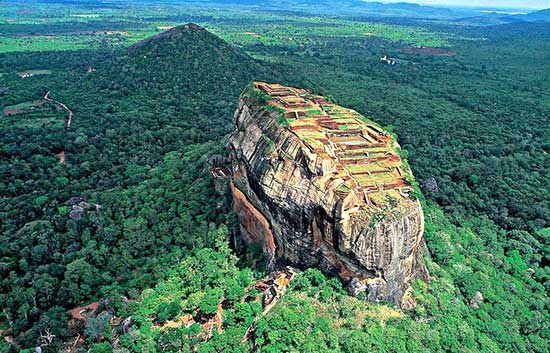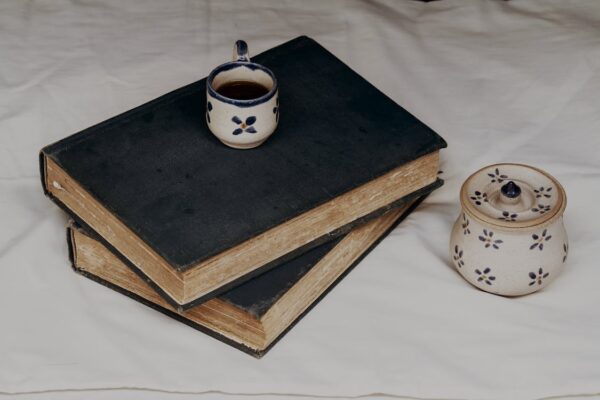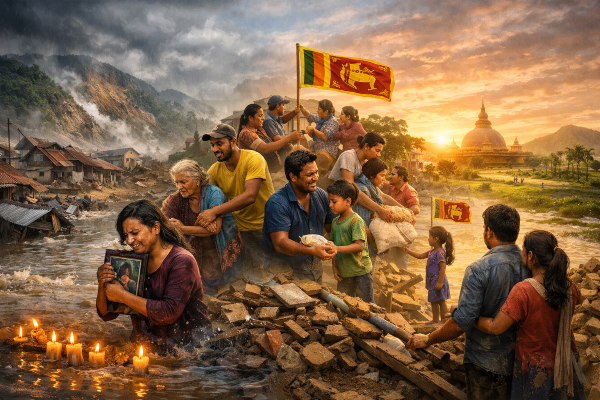THE WORLD HERITAGE SITES OF SRI LANKA-By Everyman

SIGIRIYA – THE CITADEL IN THE SKY
Source:Island
From patricide to a palace. From intrigue to ignominy. From paintings to poems. From pleasure gardens to a playboy king. Sigiriya has it all. Archaeology, history, controversy and folklore are entwined and enmeshed in the unfolding of the story of Sigiriya. Sigiriya or ‘Sinhagiri‘ – ‘Lion Rock’ derives its name from the huge rock carved lion located on a small plateau on the Northern side of the rock. Over the decades the top part of this lion has fallen apart and today only the two mammoth front paws are visible forming an entrance between them. The rock itself is the remains of hardened lava which would have pushed through the ground surface causing a volcanic eruption. According to geologists this could have happened over two billion years ago. Around Sigiriya there still can be seen numerous granite boulders which are also remains of the lava that formed Sigiriya. With the recent passing away of Prince Phillip, Duke of Edinburgh it may interest readers to know that one of the most famous lava created rocks is in Edinburgh , capital of Scotland. On top of this rock lies the magnificent Edinburgh Castle, built in 1103 In 1831 a British Army Major, Jonathan Forbes while riding on horseback through the country stumbled on Sigiriya which was amongst the jungles and scrub land of the Matale District. And for the first time the Western world, in particular Britain, under whom Ceylon (as it was then known ) was a colony, came to know about Sigiriya. In the 1890’s the first extensive archeological excavation on Sigiriya was done by the Archeological Commissioner, H.C.P. Bell who was appointed by the British Governor, Sir Arthur Gordon. Later on in 1982, full scale archeological excavations to restore Sigiriya began through the Sri Lankan Government funded Cultural Triangle Programme. It was in that year that Sigiriya was inscribed on the UNESCO World Heritage Site lists. Also inscribed were The Ancient City of Polonnaruwa and the Sacred City of Anuradhapura. These three sites were the first in Sri Lanka to gain this distinction. However within the pages our own ancient chronical the ‘Culavamsa’, the story of Sigiriya can be traced. Actually the story of Sigiriya commences with the reign of King Dhatusena. Having defeated the Pandyan invaders he was crowned King of Sri Lanka in 549 CE and ruled from Anuradhapura. Despite his fame for developing agriculture and thereby meeting the needs of the people by constructing 18 irrigation tanks, he also performed his kingly duties as a devout Buddhist by erecting the now famous 43 ft tall Avukana statue of Lord Buddha.
Yet, King Dhatusena had a streak of cruelty. Migara the chief of the King’s army was married to King Dhatusena’s favourite daughter. While his mother was King Dhatusena’s sister. In all probability it was due to this family connection that Migara was made the Chief of the Army ( Senapathi ). However for reasons unknown, Migara was extremely cruel to his wife. Being unable to apprehend Migara, King Dhatusena vented his fury on Migara’s mother, his own sister, and ordered her to be burned alive.
From that point onwards, the story of Sigiriya unfolds like a Shakespearian tragedy. Migara’s heart and mind burned within him to take revenge on King Dhatusena. Avenging his mother’s cruel death became a maniacal obsession. And so he planned and plotted and found a ready, willing and able person whom he could inspire and instigate to fulfill this overriding obsession. This person was none other than King Dhatusena’s eldest son, Kasyapa. However Kasyapa though being the eldest son had no right to the throne since his mother was a Non- Royal concubine. Kasyapa knew it. He resented it.
Thus was planned between Migara the Chief of the Army and Kasyapa the King’s son a Royal coup. Fast Forward to 1962- A ‘Royal’ coup also involving a high ranking Army Officer. That was a failed coup. But that as they say is another story! Let’s move on. Migara who had won the fullest confidence of Kasyapa and knew very well how to exploit it arrested King Dhatusena and de-throned him. He then had Kasyapa enthroned as King. This was in 473 CE. The first step in this coup had been completed.
Now for the second. He convinced King Kasyapa that Dhatusena had large amounts of treasure, specially gold hidden in some secret place. Dhatusena was then confronted by the new king Kasyapa, who demanded to know where the hidden treasure was. Dhatusena took his captors to the borders of the Kalawewa which was one of the largest irrigation tanks he had built and taking some water from the tank in his hands, exclaimed that this was the only treasure he had. Infuriated and exasperated King Kasyapa ordered Migara to entomb his father alive into a wall.
According to an alternate story Dhatusena was buried alive on the bund of the Kalawewa. Whichever way the murder took place, Migara had avenged his mother’s murder. Meanwhile Moggallana, the rightful heir to the throne fled to India as he feared that he too would be killed. But the dastardly act of King Kasyapa incurred the ignominy of the people and the venerable monks. Patricide was something that could never have been condoned. It was against the teaching of Lord Buddha. King Kasyapa was a troubled man. The people were against him. The venerable monks were against him. His step-brother brother Mogallana was against him and was collecting an army of invasion. And to add to his misery he was constantly and contemptuously referred to as ” Pithru Ghatathaka Kasyapa.” ( Kasyapa –the paricide ) Abandoning Anuradhapura as his capital he moved to Sigiriya which was once a Buddhist monastery.. Here he built his fortress and his palace which has been called the eighth Wonder of the World. King Kasyapa felt well secured. He had left behind his fears and apprehensions. He now wanted to live in luxury. He lavished his wealth to make into reality his vision of creating a city similar to the mythological ‘Alakamanda’ –the ‘City of the Gods’ which was ruled by Kuvera, the god of plenty and prosperity.
Rising 200 meters from ground level the summit provides a 360 degree panoramic view of the adjacent jungles. Here was a unique harmony between nature and human imagination. It was also of strategic importance because any enemy army moving in, can be detected and defensive measures taken.
As any of today’s visitors enter through the Western gate what greets the eye are the royal gardens, interspersed with pools and fountains. These gardens were meant to be a type of pleasure park for the exclusive use of the royal family to relax. They extend for a few hundred meters from the base of the rock. And now begins the climb to the summit, which is not for the faint hearted as we shall see later. The massive brick stairways leads in a zig- zag to the Mirror Wall. Let us pause here for a while. According to one source the Mirror Wall was made from a special plaster comprising fine lime, egg white and honey. It was then buffed with bee’s wax to give a brilliant luster. In King Kasyapa’s time it was so well polished that the King could clearly see his refection as he walked by. Was it a sign of his vanity ? After all here was his palace which he believed to be similar to ‘The City of Gods’. And as the King was he not like Kuvera? If indeed it was his vanity he felt justified. Passing the Mirror Wall is a platform. No matter how intrepid you are it is better to pause awhile and take some deep breaths. More challenges lie ahead. There is a narrow metal staircase which leads to the frescoes. It is best to stop here and admire these semi-naked doe-eyed beautiful women. They are like heavenly nymphs (apsaras). There is much conjecture as to whom they depicted. Were they the King’s many wives, or members of the play-boy King’s Royal harem ? It is claimed that he had over 500 damsels selected for their sensuous beauty.
Having passed these damsels perhaps with some regret, one comes to the most difficult part of the climb. There is a narrow steel stairway on the exposed side of the rock. It is best not to look down below on the lush green scrubland. You may get a bout of acrophobia! And so we come to the summit and you can breathe a great sigh of relief not only for overcoming the challenge of climbing but also gazing at the magnificent landscape that stretches as far as eye can see.
This terraced summit is approximately 1.6 ha in extent. Here can be seen a number of water tanks, baths and the remains of the Royal Palace. There is also a stone slab like a seat which may have been the remains of a throne. There is also a 27 m x 21 m rock hewn water tank which was a water storage tank. The hydraulic systems, the landscaping, the terraces, all of these indicate unique creative skills and technologies. Sigiriya is said to be one of the finest examples of urban planning of the first millennium.
But we now need to get back to the Mirror Wall for there is a story to relate. On this Mirror Wall there can be seen graffiti in the form of poems written in Sinhala, Sanskrit and Tamil. According to historians and archeologists these graffiti were written long after Sigiriya was abandoned and converted once more into a Buddhist monastery. And then the question arises as to why these monks allowed visitors to enter and write poems on the Mirror Wall , many of which were love poems ? For example –
“Wet, cool dew drops Fragrant with perfume from flowers, Came the gentle breeze, jasmine and water lily Dance in the spring sunshine. Side- long glances of the golden hued ladies stab into my thoughts. Heaven itself cannot take my mind, As it has been captivated by one lass Among the five hundred I have seen.”
It must be noted that these graffiti is of great interest to scholars as it reveals the development of the Sinhala language and script.
But the saga of Sigiriya does not end. Once more the cold steel hand of intrigue and betrayal appears. And this time too it is Migara’s hand. And once more it is anger. And once more it is revenge. This time the victim is King Kasyapa. Annoyed that King Kasyapa did not permit him to conduct a large religious festival Migara secretly switched his loyalty from King Kasyapa to his half brother Moggallana who was in India waiting for an opportunity to return to Sri Lanka and regain the crown that was rightfully his.
Migara’s secret changing of loyalty was Moggallana’s cue to return. On hearing of this new but not unexpected threat King Kasyapa riding his Royal elephant and confident of his army, led by Migara, went into battle. This, despite his soothsayers warning him that it was not the auspicious time for war. At some point, his elephant sensing a swamp close at hand turned to get on to firmer ground. To Migara this was an opportunity sent by the gods. He ordered the army to retreat.
The army fled. King Kasyapa was now alone and abandoned . He knew that his end was near. Rather than being killed in battle he drew out his dagger placed it on his neck and slit his throat. It was in the year 495 CE. He had ruled for 18 years. Moggallana the victorious was not unmindful of his duties. He still respected his half brother and accorded him a Royal cremation. It is believed that the place was at Pidururangala. It is a few km away from Sigiriya and is also like Sigiriya formed by volcanic activity.





















